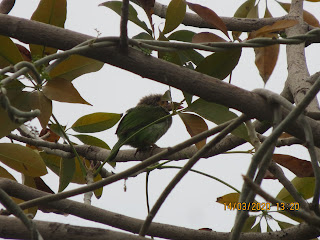I first saw this bird on my sister's phone as she had caught the birding bug from me and took a shot on her way to meet me. Then, I had a chance to see it up close at my parents home. My parents home is on a higher floor and very close to the Sanjay Lake Park, where we have a few trees very close to our balcony, which offers an ideal spot for many birds to come by. My favourite activity when I reach their home is to sit on their balcony!
Just like that there it was the brown-headed Barbet.
It was quite a rainy and windy day, but here is the close up:
They look very similar to the other species which is a Lineated Barbet.
There are 30 or 80 species of this bird from Tibet to Indonesia. They usually live in the inner forests.
I have seen two types but mostly only as singles. So, my reading confirms that they are solitary birds.They feed on fruits and insects. They love figs, so you may spot them on fig trees easily.
Barbets are considered important birds for seed dispersal. From Youtube I learnt that it is a Barbet call I wake up to on most days but never recognized the call. It is a repetitive and long sound like a "Kuk kuk kuk" or "Kutroo kutroo kutroo". They can go on and sound maddening at times.
Here are few more shots of the Barbet:
Nesting Season: Overall March to June.
They usually nest in a hole of a dead tree- trunk or branch.
3 to 4 eggs, and both sexes share all domestic duties.
Recently after M S Dhoni saved a Barbet, I learnt there was another variety named Copper Smith Barbet too. It is beautiful and I had a chance to see one accidentally during my morning walk.
So the Coppersmith is slightly smaller, the size of a sparrow. it is mostly found on a Banyan or Peepul tree for fruit. Nesting season for this bird is January to June and it lays upto 3 eggs. It is also called the Crimson-breasted Barbet and it is green with a red head, yellow cheeks and yellow throat. Its underparts are streaked in grey and black.
Here is the accidental shot, hope to catch a clear shot soon.
But the one I hope to see and capture sometime soon is the Blue Throated Barbet.






No comments:
Post a Comment